Hyundai Ioniq 5 Charging Curve Data Analysis
We're an affiliate
We hope you love the products we recommend! Just so you know, we may collect a share of sales or other compensation from the links on this page. Thank you if you use our links, we really appreciate it!
Table of Contents
The Hyundai Ioniq 5 presents some highly remarkable charging abilities, but getting to know the Ioniq 5 charging curve would be pretty important for one to get maximum efficiency. Be able to maximize sources of charge by taking into account changes in performance brought about by different powers through charging and temperature fluctuations between sessions.
We’re going to get into the performance under different conditions and give useful, real tips for making the best out of your charge. From handling thermal impact to picking the right time to charge, make sure you are getting the most from some really impressive Ioniq 5 technology.
Hyundai Ioniq 5 Charging Curve Performance Detailed Analysis
150 kW – Ioniq 5 Charging Curve Performance Detailed Analysis

Initial Ramp-Up in Power

Starting from 10% SoC, the Ioniq 5 quickly ramps up its charging power to 140-150 kW. Good battery conditions with a temperature of 77°F prevailed at the beginning of the session, which allowed it to deliver maximum power.
Mid-Charge Performance

The mid-charge performance is fairly similar at 50% SoC. The Ioniq 5 will continue to charge at a stable 150 kW power output. Its battery temperature does rise but still stays within an acceptable window to ensure consistent charging performance.
Thermal Impact
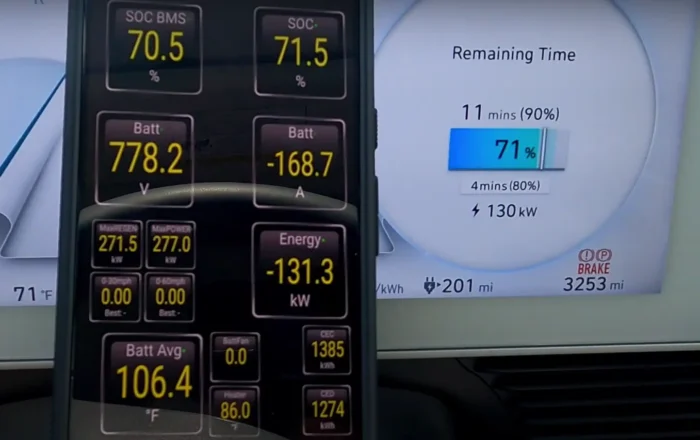
At roughly 70% SoC, when the temperature reaches 109°F, charging power tapers off slightly and holds at around 130 kW. This slight reduction probably comes as a result of thermal management that kicks in to prevent overheating of the battery.
Final Stretch

This charging session concludes with 55 kWh in 22 minutes to 80% SoC. The peak battery temperature reached 115°F, causing some slight power tapering, but this session was still completed rather efficiently within a reasonable time.
350 kW -Ioniq 5 Charging Curve Performance Detailed Analysis
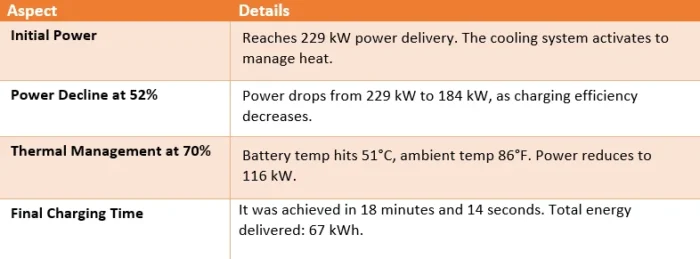
Initial Impressions: Powering Up at 10%
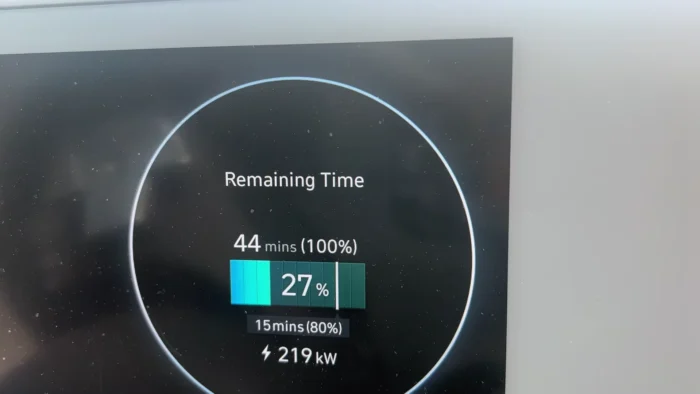
Starting at 10% battery, the Ioniq 5 ramps up to around 229kW of power, proving it has a robust thermal management system to accommodate high-speed charging.
Charging Power Decline: The Drop-off at 52%
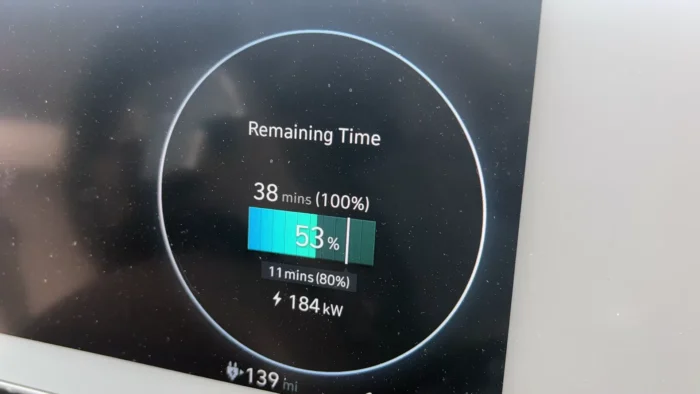
At 52%, the battery starts tailed-back charging power from 229kW down to around 184kW—an expected efficiency drop for the sake of preserving battery life.
Thermal Management: The Impact of Battery Temperature

At around 70%, the Ioniq 5’s thermal management becomes more conservative; that is, it reduces charging power to 154kW, modulating between speed and battery health.
The Final Stretch: 10% to 80% in 18 Minutes
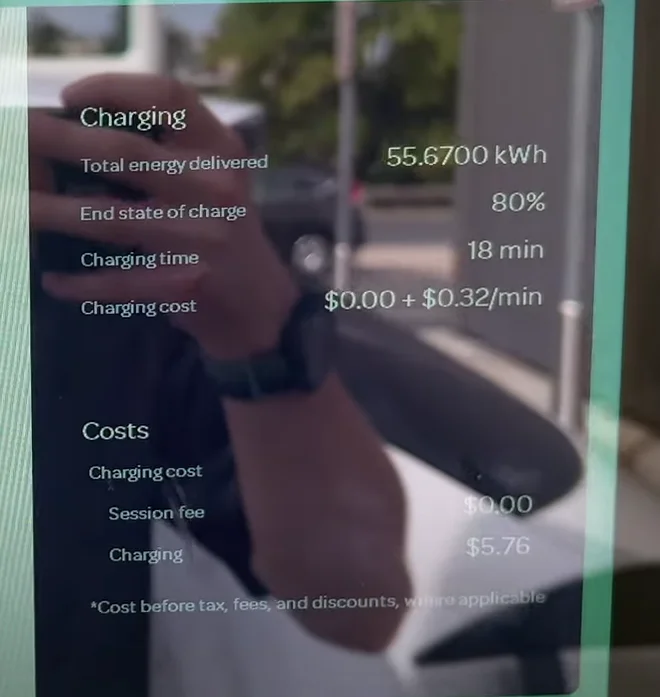
Even with thermal limitation, the Ioniq 5 hits 80% in 18 minutes and 14 seconds, providing 67kWh— an astonishing measure of its fast-charging capability.
Overall comparison of Ioniq 5 Charging Curve
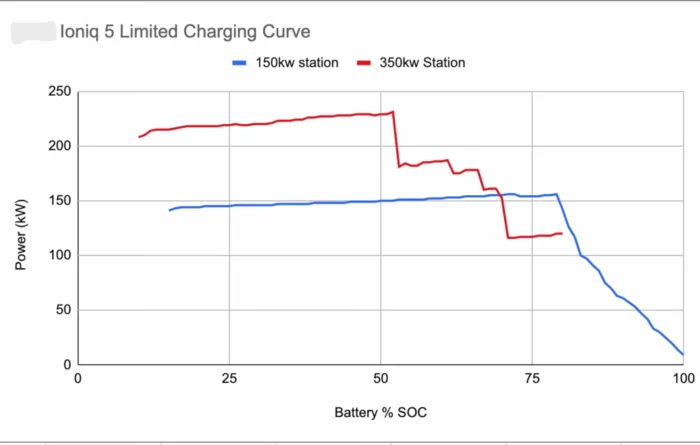
- Time Difference: Charging at 350 kW was only about 3-4 minutes faster than at 150 kW.
- Efficiency: Both sessions stayed under the 30-minute complimentary charging window typically provided by fast-charging networks.
- Cost: For those using complimentary sessions, there’s minimal difference in charging time, making both options viable depending on availability.
Charging methods to benefit from the Ioniq 5 Charging Curve
- Level 1 Charger is standard 120V, while Level 2 Charger is standard 240V home chargers. This operation is much more gentle on the batteries and is ideal when overnight charging or if an individual doesn’t need a full charge immediately.
- DC fast chargers, which are Level 3, are designed to quickly replenish the battery. Best for long trips or when you need to get a quick boost; however, frequent use will put additional stress on the battery over time.
- Use quick charge for long road trips or in times when you need quick charging. Avoid continuous fast charging with daily top-ups since this may increase additional wear on batteries over time.
- The health of your battery can be kept in the best condition by limiting fast charging applications. Repeated recharging at a fast speed will bring about faster degradation of the batteries.
- For everyday use, maintain a charge in your battery between 20% and 80%. Charging to 100% is best kept for long journeys or special cases since it gives more stress to the batteries, thereby reducing their life.
- You can monitor the temperature and charging rates via the Bluelynk app or the vehicle’s onboard display. For instance, when you notice your battery temperature is a little higher than usual, you may want to adjust your charging plan or park in a cooler environment.
Tips for Optimizing Charging in Cold Weather
Some users have experienced difficulties and doubts about charging the Ioniq 5 in cold weather; these are some tips for overcoming these challenges and optimizing your charging efficiency.

- Use the car’s preconditioning feature to warm up the battery before you start charging. This helps maintain optimal charging speeds and efficiency.
- If available, use a high-power charger to minimize charging time and improve efficiency.
- If possible, schedule charging during the warmer parts of the day to avoid the impact of extreme cold on charging speeds.
- Keep an eye on the charging rate and be prepared for slower speeds in very cold conditions, even if using high-power chargers.
Maximizing Charging Efficiency in Hot Weather
Some Hyundai Ioniq 5 owners have discussed their experiences with charging in extremely hot weather. Here are some practical tips to help you optimize your charging efficiency during high temperatures.

- Use the app to pre-chill your vehicle before charging, so you have a comfortable cabin temperature at the start of your drive and decrease energy consumption while driving.
- Charge your vehicle during the coolest part of the day, either early in the morning or late in the evening, to avoid the full impact of elevated ambient temperatures on charging efficiency.
- Keep your vehicle under the shade or any covered areas whenever possible to help keep your battery and cabin cool. This relieves loads from the cooling systems.
- Check the battery temperature regularly, and ensure the charging rate is kept within the recommended limit to prevent overheating.
- Put the air-conditioning system into service in order to keep the temperature inside comfortable but at the same time be careful with the overall energy consumption and charging efficiency.
Conclusion
The charging capabilities of the Hyundai Ioniq 5 depend on the selected power level and the thermal condition of the vehicle at that moment, thus affecting efficiency and health. You can improve your charging experience to keep the battery running at optimum by following the strategies outlined here for different weather conditions and using the tools available.
Categorised in: Advice, Automotive





